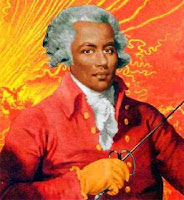Editor's note: today's blog post is written by guest blogger Lisa Myers Bulmash.
It is nice to point out heroes of color during
Black History Month, like legendary poet/playwright/author Langston Hughes, but
as readers of the Black Past blog well know, black history is something
everyday people create, every day. For the past four decades, the Langston
Hughes Performing Arts Institute (LHPAI) has created performing arts history
vital to the Seattle African American and Diaspora community.
 |
| Synagogue Bikur Cholim |
The Institute seems to have always been part of the Central Area, and, in a way it has:
its landmark building was originally erected as the Chevra Bikur Cholim
congregation's synagogue and dedicated in 1915. At that time, the Central Area
was a mostly Jewish neighborhood with some residents of black, Japanese, and
Scandinavian heritage.
More black people began to move to Seattle during
World War II, but were restricted to the Central Area by job and housing
discrimination. It took long-term challenges from dozens of Seattle civil
rights activists and thousands of demonstrators and protestors of all racial
backgrounds in the 1960s for the city and state to improve housing, educational
and recreational opportunities for blacks and other people of color.
By
the late 1960s many of these activists, including most prominently Walter Hubbard, Jr., sought a chance to establish a cultural
center in the Central Area. That chance
arrived in 1968. The congregation of Bikur Cholim sold its synagogue to the
City of Seattle as many of its members migrated out of the area south to Seward
Park and east to Mercer Island and other suburbs. In 1969 Walter Hundley and Seattle’s leading
anti-poverty organization, the Central Area Motivation Project (CAMP) created an unusual partnership with the City of Seattle. CAMP utilized the City's
federal urban renewal funding to help create the Langston Hughes Cultural Arts Center.
 |
| LHPAI exterior |
The
Center was managed by Seattle Parks and Recreation Department as an African
American-focused community center. Its
founders however, had another purpose in mind; the Center would also be an arts
organization that would serve as a venue for plays, poetry readings, and other
performance art. Then as now, the Center also offered art classes, hosted organizations like the Madrona Youth
Theatre, and rented out its performance and meeting space. But there was always
tension between the twin foci of the Center. One early Center advisor captured
that tension when she described it as “a recreation center that does not do
basketball.”
 |
| Montlake School, 1975 |
Despite
these conundrums, by the early 1970s the Cultural Arts Center became the major
force shaping Seattle's African American arts scene, cultivating and promoting
numerous local performing artists. These performers included local actors Umeme and Kibie Monie. The center also became a focal point for out-of-town talent who began arriving in the 1980's. Among these were Jacqueline Moscou who acted and directed in several productions and director Michelle Blackmon, who, in 1999, staged
“Purlie Victorious” (by playwright and legendary actor Ossie Davis seen here with then-Executive Director Stephen Sneed).
In
2001, the Seattle Parks Department, recognizing the growing importance of the
Cultural Arts Center’s role in the local performing arts scene, approved a
reorganization plan to focus more strongly on this part its mission. That reorganization included a name change to
the “Langston Hughes Performing Arts Center.” This change brought in Jacqueline Moscou as its first artistic director. She staged several theatrical productions, including "Death of a Salesman" with an all-black cast in 2005. (This innovation was not repeated on a major scale until the 2009 Yale Repertory Theatre production, starring Charles Dutton). The new Center adopted a dance
company-in-residence and started an artist-in-residence program. The Center
also launched its annual film festival in 2003, expanding the event's duration
from three to nine days in 2007.
The weight of all that
history took a structural toll, forcing a building closure from 2010 to 2012
for seismic and electrical renovation. Since its reopening in 2012 as the Langston Hughes Performing Arts Institute (LHPAI), the organization
has continued to offer authentic African American and Diaspora performing arts to all of Seattle. LHPAI transferred from the parks department to the Office of Arts and Culture in 2013 and has established a dance company-in-residence as well as an artist-in-residence program. Royal Alley-Barnes, LHPAI's executive director since 2009, increased infrastructure resources, community connections, and emphasis on the mission to ensure the focus on local and grassroots artists continues. The institute also offers winter and summer performing arts academies, ongoing educational opportunities, and a new website. This February marks the institute's first Black
History Month back in its home of more than forty years, an
occasion worth celebrating. We invite
all who are interested to come to the new Langston Hughes Performing Arts
Institute.
Photo credits: Synagogue Bikur Cholim: WA State Jewish Historical Society; LHPAI exterior: Joe Mabel; Montlake School 1975: Langston Hughes Performing Arts Institute; Steve Sneed with Ossie Davis: LHPAI



